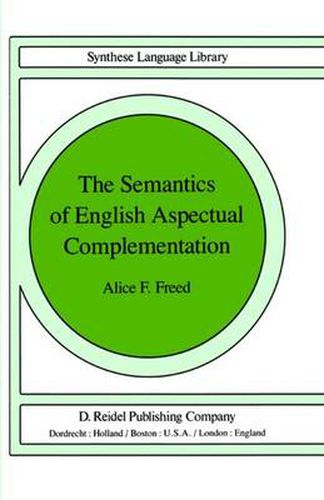Readings Newsletter
Become a Readings Member to make your shopping experience even easier.
Sign in or sign up for free!
You’re not far away from qualifying for FREE standard shipping within Australia
You’ve qualified for FREE standard shipping within Australia
The cart is loading…






This title is printed to order. This book may have been self-published. If so, we cannot guarantee the quality of the content. In the main most books will have gone through the editing process however some may not. We therefore suggest that you be aware of this before ordering this book. If in doubt check either the author or publisher’s details as we are unable to accept any returns unless they are faulty. Please contact us if you have any questions.
Complementation has received a great deal of attention in the past fifteen to twenty years; various approcahes have been used to study it and different groups of complement-taking verbs have been examined. The approach taken here employs analytic techniques which have not been systematically applied before to this group of temporal aspectual verbs. In other works which have concentrated on these same verbs (perlmutter, 1968, 1970 and Newmeyer, 1969a, 1969b) few insights about the semantic properties of the verbs are formalized. In the present study, the various verbs and their complement structures as they appear in surface forms are considered for their associated presuppositions and consequences (entailments). The notions of presup position and consequence are defmed and used so as to take conversational interaction into consideration. This adds considerably to the information that can be obtained about the verbs in question. Furthermore, the analysis of these temporal aspectual verbs leads to a description of their complement structures in terms of ‘events’, a semantic category found to appropriately characterize the quality of most of these structures. In this analysis, events are described as consisting of several different temporal segments; thus the sentences contained in the complements of these verbs are described as naming events, each containing one or more of several possible temporal segments. The aspectualizers in tum, act as referentials, each referring to one or another of the event-segments named in their complements.
$9.00 standard shipping within Australia
FREE standard shipping within Australia for orders over $100.00
Express & International shipping calculated at checkout
This title is printed to order. This book may have been self-published. If so, we cannot guarantee the quality of the content. In the main most books will have gone through the editing process however some may not. We therefore suggest that you be aware of this before ordering this book. If in doubt check either the author or publisher’s details as we are unable to accept any returns unless they are faulty. Please contact us if you have any questions.
Complementation has received a great deal of attention in the past fifteen to twenty years; various approcahes have been used to study it and different groups of complement-taking verbs have been examined. The approach taken here employs analytic techniques which have not been systematically applied before to this group of temporal aspectual verbs. In other works which have concentrated on these same verbs (perlmutter, 1968, 1970 and Newmeyer, 1969a, 1969b) few insights about the semantic properties of the verbs are formalized. In the present study, the various verbs and their complement structures as they appear in surface forms are considered for their associated presuppositions and consequences (entailments). The notions of presup position and consequence are defmed and used so as to take conversational interaction into consideration. This adds considerably to the information that can be obtained about the verbs in question. Furthermore, the analysis of these temporal aspectual verbs leads to a description of their complement structures in terms of ‘events’, a semantic category found to appropriately characterize the quality of most of these structures. In this analysis, events are described as consisting of several different temporal segments; thus the sentences contained in the complements of these verbs are described as naming events, each containing one or more of several possible temporal segments. The aspectualizers in tum, act as referentials, each referring to one or another of the event-segments named in their complements.